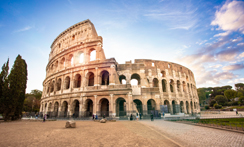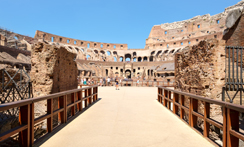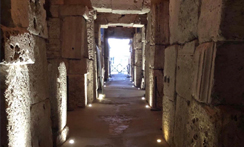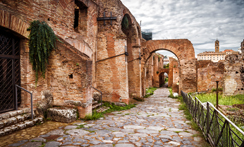Overview
So, you are coming to Rom and of course you want to visit the Colosseum. The Colosseum is the ultimate icon of the power and might of the ancient Roman Empire. For that very reason it is the MOST visited site in Rome and Italy with 7.5 million visitors in 2019. There are a number of different options for visiting the colosseum; there is the standard ticket, arena entrance and the underground - it can be confusing – so what is the difference in these parts of the colosseum and are they worth it? All tickets to the Colosseum include access to the Roman Forum and Palatine Hill – the city centre and Beverly hills of ancient Rome.
Kolosseum
The Colosseum as we call it today was the largest amphitheatre (double theatre) in the Roman empire. It hosted some of the most exciting and lavish games including animal hunts, public executions turned into spectacles and the famous gladiator combat we know from the film Gladiator. Spectators once crowded into this stadium for an entire day of events at the expense of the emperor. The Kolosseum is the largest and most complicated building the Romans achieved and is still a wonder of architecture, engineering and ingenuity. Our stadiums today are not unlike the Colosseum, we could even call it a blue print for our modern buildings; there were tickets, numbered entrances, seats graded according to social status (like our private boxes and cheap seats today). There were plenty of services and amenities: a retractable awning or canopy for the sun and rain, toilets, food stalls, betting shops and souvenir stands and like today before the games there would have been posters on display listing who was performing.
Highlights
Looking over the arena from behind the cross (ground level)
Ludus Magnus from above (second level)
Exhibition – machine reconstructions, statues, graffiti, food items and animal skulls
Colosseum Model - reconstruction in wood
Viewing platforms above the two-long axis with views over the arena
Viewpoint over Arch of Constantine and Temple of Venus and Roma
GESCHICHTE
The Colosseum was conceived by the Emperor Vespasian who followed after Nero, he wanted to make his mark and so constructed the first permanent amphitheatre in Rome. The ‘Flavian Amphitheatre’ as it was known was built on the site of the lake of the golden house of Nero. It took 10 years to build from lake to stadium, two years to drain the lake and dig foundations and a further 8 to mostly complete the superstructure. Vespasian died in 79 A.D. and his son Titus completed and inaugurated the building in 80 A.D. with 100 days of games. Over the next three hundred years the building was added to, damaged and repaired and then in the 6th century abandoned. Rome could no longer afford the lavish games.
What to expect
Today the Colosseum is a major tourist attraction and can be very busy. It is advisable to book your tickets ahead of time or take a guided tour.The building has been ravaged by time, only part of the original outer ring still survives but it is enough to get a sense of the enormity and complexity of the building. Two levels are accessible with the standard ticket, you can explore the first level (ground floor) on the most complete side and the second level allows you to look over onto the arena and into the underground from above. Here you can appreciate how large this stadium was as the remaining walls tower above on the north side of the building. From the outside ring of the second floor you can look over at the Ludus Magnus (gladiator barracks). On the inside is the permanent exhibition space which a number of interesting items: reconstructions of the machinery used in the underground, graffiti of gladiators left by spectators and artefacts found in the sewers of the colosseum remains of food (chicken bones, clam shells, oyster shells, fruit and vegetable seeds and husks of nuts) and souvenir oil lamps with different animals and gladiators on. You shouldn’t miss the huge wooden replica of the colosseum made in the 1800s which shows the building complete with seating, the internal corridors and stairwells. From the platform by the shop (the destroyed side you will have a great view of the Arch of Constantine and the Temple of Venus and Roma.
Interesting facts
The Colosseum is the largest amphitheatre ever built in the Roman empire. It is 48.5m high, 188m long and 156m wide.
Over 100,000 cubic metres of travertine were used in the Colosseum, mostly for the outside and the arches. This equates to 300 carts a day for 6 years driving to Tivoli and back (33km).
Over 300 tonnes of iron were removed from the colosseum leaving it looking look a Swiss cheese.
It is estimated around 250,000 people worked on the Colosseum. They were certainly not all slaves but skilled tradesmen like engineers, architects, carpenters, scaffolders, stonemasons and sculptors, brick layers, brick makers and basket weavers to name just a few.
The Colosseum metro built in 1937 curves around the colosseum. It runs along the south-west end of the colosseum between the Colosseum and the Arch of Constantine. Sometimes you can feel the vibrations underground.
In 2018 Beyoncé and Jay-Z were denied permission to film a music video inside the colosseum for their ‘On the Run’ tour.
Frequently Asked Questions
How many spectators? Modern estimates often say 50,000 spectators but evidence from the 4th century A.D. suggests as many as 87,000 people – remember the ancient Romans were smaller than us!
What happened to the seats? When the Colosseum was hit by earthquakes the substructure of brick and concrete holding up the seats was the first to collapse. The marble and stone seats were probably the first pieces to crumble, be taken and recycled.
Did Spartacus fight here? No. Spartacus lived a century before the Colosseum was built, he trained and fought at the amphitheatre in Capua near Naples.
How did you get a ticket? This is one of the unanswered questions… we know tickets were free and probably given out by the emperor/general/politician who paid for the games. Perhaps it was a system of friends of friends, or perhaps first come first served. The senators and prominent politicians had their own permanent seats with names on. Other than that, it is still a mystery!
What are all the holes on the outside? The travertine blocks on the outside of the Colosseum were not held together with mortar but with iron pins or staples. Centuries after the colosseum was built, the Romans dug out the iron and recycled it, leaving the holes we see today.
How often were the games?Games were held in Rome for different religious festivals throughout the year. At the Colosseum the games were very expensive to put on so they were around 5 days. The Colosseum wasn’t open every day.
What happened to the Colossus of Nero?The 30m statue of Nero as a Sun God that gave the Colosseum its name disappeared sometime in the 700s A.D. Like everything in Rome, it would have been recycled – melted down and re-used.
Was it always to the death?No. Although we get the impression that this was a blood sport enjoyed for violence, the Romans came to see a good fight like we watch boxing or wrestling today. The trained gladiators were too expensive to lose at every fight.





